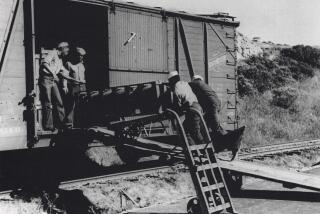Names of Guantanamo detainees set for transfer are revealed
The Obama administration Friday disclosed the identities of 55 prisoners who have been cleared for release from the Guantanamo Bay detention center for terrorism suspects.
The reversal of its long-standing policy of keeping the names confidential means defense lawyers for the men no longer considered a threat to U.S. or international security can try to find countries willing to take them in.
An additional 31 prisoners were cleared for transfer home or resettlement in third countries after a review of the grounds for holding each detainee ordered by President Obama shortly after he took office in January 2009.
It wasn’t clear why some identities hadn’t been disclosed, although the list, compiled from habeas corpus actions underway in U.S. federal courts, included a note that cleared detainees “whose transfer status is protected by sealed orders” of the court were not included.
Most of those who have had to remain at the prison complex at the U.S. Navy base in southern Cuba are from Yemen, where repatriations were suspended almost as soon as they had begun last year because of concerns about the detainees being drawn to the side of Al Qaeda-aligned militants in control of key territory in the country.
Others eligible for release but with no place to go include citizens of Syria, where a civil war is raging, and Tunisia, where until last year’s rebellion against an entrenched dictatorship it was feared the men could face torture or mistreatment.
A U.S. government statement said the administration had kept the names of cleared detainees secret “to maintain flexibility in its diplomatic engagements with foreign governments on potential detainee transfers, especially in cases of resettlement in third countries.”
The policy was changed, the statement said, because fewer of the captives eligible for release were unable to return to their native countries. That was presumably a reference to the fall of authoritarian governments in Tunisia, Egypt, Libya and Yemen in the nearly two years of rebellion in the so-called Arab Spring.
“Today’s release is a partial victory for transparency, and it should also be a spur to action. These men have now spent three years in prison since our military and intelligence agencies all agreed they should be released,” said Zachary Katznelson, senior staff attorney on the national security project of the American Civil Liberties Union.
Three of those named Friday are Chinese Muslims of the Uighur minority in rebellion against the Beijing leadership but not against the United States or other Western countries. Other Uighurs captured in Afghanistan and Pakistan after the U.S.-led invasion in late 2001 have been sent to Albania, Bermuda and Cape Verde. The three remaining had been offered refuge in the South Pacific nation of Palau but declined to go there.
Katznelson, who has fought the practice of indefinite detention of terrorism suspects since the early days of the Guantanamo offshore prison, noted that Yemeni Adnan Farhan Abdul Latif was not on the list released under the ACLU’s Freedom of Information Act request. Latif, 36, was found dead in his cell in the maximum-security Camp 5 compound on Sept. 8.
The Pentagon has yet to release a cause of death, but Latif’s attorney, Marc Falkoff, wrote in an op-ed commentary for The Times this week that his client had previously attempted suicide and might have taken his own life.
There are 167 men left at Guantanamo – four of the serving prison terms for convictions on war crimes and six facing capital trials for allegedly plotting the Sept. 11, 2001, terrorist attacks. Forty-six of the prisoners were deemed in the 2009 review by intelligence and legal experts to be too dangerous to release even though the Pentagon had too little evidence with which to prosecute them.
ALSO:
New Mexico suspends not students, but school board
4 Texas men sentenced in sexual assault on 11-year-old
Man mauled, critically injured after leaping into tiger den at Bronx Zoo
More to Read
Sign up for Essential California
The most important California stories and recommendations in your inbox every morning.
You may occasionally receive promotional content from the Los Angeles Times.











